British Mandate (1917-1948)
In 1917, towards the end of World War I, the British conquered Palestine from the Turks and ruled under a mandate thirty years until 1948. The atmosphere in Jerusalem changed drastically. The British army began constructing 'security zones', Jews who lived and worked inside the zones were forcibly evicted, and were ordered to abandon their shops and offices.
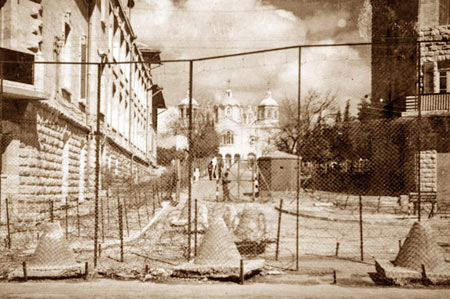 |
| |
Jerusalem's security zone "Bevingrad" with the Russian Holy Trinity
Cathedral in the background. In the foreground "dragon's teeth", British
reinforced concrete protection against vehicles and tanks |
 |
|
| |
 |
| |
|
| |
British foreign minister Ernest Bevin |
The central 'security zone' in Jerusalem was set up in the Russian Compound. It was seen as a symbol of British oppression in Palestine, and was nicknamed "Bevingrad" after the viciously anti-Semitic British Foreign Minister Ernest Bevin, hated by Palestine's Jews because he tried to placate the Arabs by putting a lid on postwar Jewish immigration.
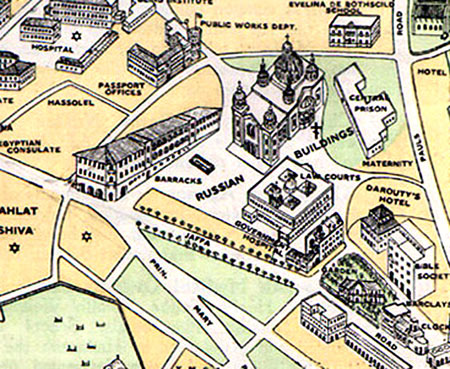 |
| |
Map of the Russian Compound during the British Mandate with Passport
offices, police barracks, law courts and central prison |
The whole area bounded by Shivtei Israel, Heleni HaMalka and the Jaffa Road, with the Russian Compound at its heart, was a fortified administrative area containing the vital installations of British rule, cordoned off by barbed wire fences and entrance was by identity card only. It became a centre of government administration, the buildings were converted into government offices, housing police headquarters and courthouses as well as the Immigration Office in the Sergei Courtyard where the British denied Jews the certificates they desperately needed for immigration to Palestine.
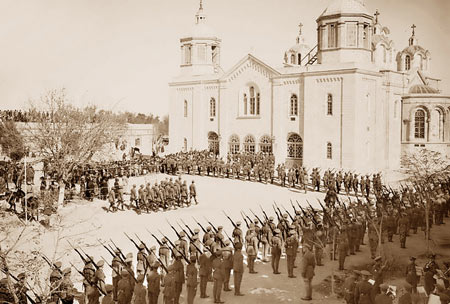 |
| |
British general Sir Edmund Allenby's march into the Russian Compound, 1917 |
You might get a hint of what Bevingrad was like by walking along Heleni HaMalka Street, still fenced off on its southern side with railings and barbed wire.
 |

|
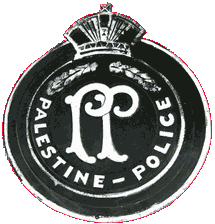 |
| |
Above: Her Majesty's Palestine Police Force's Logo
Left: Underground fighter Yehezkel Altman, a member of Irgun, waiting for visitors
at the Jerusalem Central Prison
|
The British overseers of Palestine stiffened their grip on the necks of the Jews in direct proportion to the Arabs’ penchant for stirring up violent riots. In response, the Jewish underground, comprising groups like the Haganah, the Palmach, the Lehi, and the Irgun increased their activities, which led to many of their members being jailed. The former women’s hospice was converted into the central prison of Jerusalem (“Hamerkazia”), and was used for the detention of members of the Jewish underground resistance groups who were incarcerated together with Arab and Jewish criminals before being transferred to the main prison in Acco.
> read more about the Jewish underground
| |
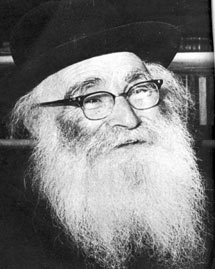 |
| |
|
| |
Rabbi Aryeh Levine, the famous
"Rabbi of the Prisoners" |
In 1931 the British authorities requested that the Chief Rabbi appoint a prison chaplain who would visit the captives on Shabbat. Rabbi Aryeh Levine became famous as the "Rabbi of the Prisoners". Every Sabbath, he would walk from his modest home in nearby Mishkenot Yisrael to the Russian Compound to conduct services with the prisoners and keep them company. He was known as the "tzaddik (righteous person) of Jerusalem." In 1965, "Rav Aryeh" was honored at a ceremony assembled by the veteran underground resistance fighters. Timed to take place on his eightieth birthday, it was held in the courtyard of the old central prison in the Russian Compound.
> read more about Rabbi Aryeh Levine
As British control over the political situation in Eretz Israel steadily weakened, harsher measures were enacted. The British finally decided to begin executing Jewish underground prisoners in the prison. In 1947, two condemned Jews, Meir Feinstein and Moshe Barazani, blew themselves up in the night before their execution with a hand grenade which had been smuggled into the cell inside of an orange.
> read more about Meir Feinstein and Moshe Barazani
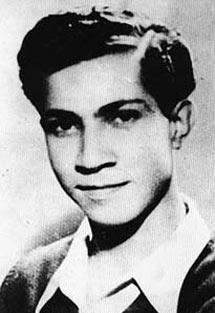 |
 |
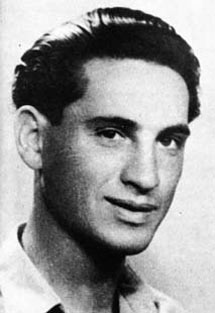 |
| |
|
|
| Moshe Barazani, a member of the Lehi underground group, the "Freedom Fighters of Israel" |
|
Meir Feinstein, an Irgun operative who was injured while launching a railroad attack in Jerusalem |
At midnight on Friday May 14 1948, the British declared its civil and military authority in Jerusalem to be at an end. In the morning they evacuated the city in two large convoys, one moved north towards Haifa and the other south towards Bethlehem. The Haganah, with the aid of sympathetic British and Jewish government employees, managed to get hold of the exact timetable of withdrawal and move in to take this strategic area immediately on its vacation and ahead of the Arabs.
Underground fighters of the Irgun first took over the vacant Generali building on the corner of Jaffa and Shlomzion Hamalka streets. After raising the national flag above the statue of the winged lion on the roof, they turned towards the Russian Compound. Many members of the Irgun force had been incarcerated in the central prison and felt particular satisfaction in returning there as victors.
The Generali building on Jaffa street
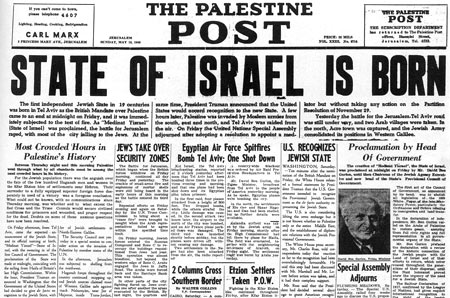 |
| |
The front page of the Palestine Post on Monday, May 14th 1948:
“The first independent Jewish state in 19 centuries was born in Tel Aviv” |
| |
|
 |
 |
| |
|
| |
UN partition plan for Palestine 1947 |
| |
|
Just three years after the end of World War II, and the death of over 6
million Jews, the state of Israel was created on May 14, 1948. Keeping in
line with the Balfour Declaration, after World War I the Palestinian Mandate
was assigned to the United Kingdom by the League of Nations thereby
designating the UK administer of Jewish affairs in the region. However, on
November 29, 1947, the United Nations voted to terminate the British Mandate
of Palestine and to resolve the Arab-Israeli conflict with the United
Nations Partition Plan for Palestine. The original plan was to have
partitioned the territory of Palestine into Jewish and Arab states, with
Jerusalem and Bethlehem falling under international control.
Arab leadership strongly opposed the plan for an independent state
within Palestine which, at the time was 67% non-Jewish. The Arab League also
argued that the proposed divisions would leave a large Arab minority in a
Jewish controlled area.
However, on November 29, 1947, the United Nations General Assembly voted
33-13 in favor of the slightly modified Partition Plan. The 13 countries who
originally opposed this plan were: Afghanistan, Cuba, Egypt, Greece, India,
Iran, Iraq, Lebanon, Pakistan, Saudi Arabia, Syria, Turkey, and Yemen.
Interestingly enough, the UK refused to implement the plan stating that it
was unacceptable to both sides and, consequently, did not vote.
What followed was a series of massacres, terrorist attacks, a
brand new more than disenchanted refugee population (over 700,000
Palestinians fled or were driven from their homes as a result of the
settlement), and the wave of religious/political/land ownership war that
rages on today. This conflict is even evident in its linguistics. While
today’s anniversary for Jews is known as the “founding of the state of
Israel”, to the Palestinians it’s known as al-Nakba, literally translated as
“the Catastrophe”. |
|
